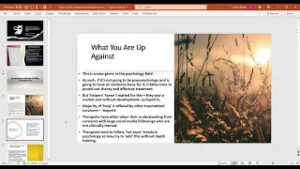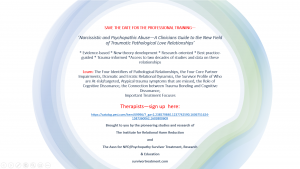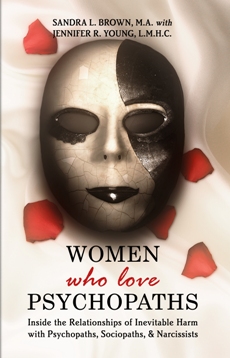By Sandra L. Brown, MA
Part of the problem we face in trying to get to the nitty-gritty of pathological love relationships is that how we do it or what we call it is judged so severely that it impairs sharing the valuable outcomes that are learned. There are groups of professionals, women’s organizations, and service agencies that tiptoe around what we call patterns of selection in relationships. There are unspoken rules and heavily weighted opinions about what we can discuss and how we discuss the outcomes.
What am I talking about? Since the 1970’s and the women’s movement, discussing the specifics about women’s choices in relationships, patterns of selection, personality traits, mental health, and sexual addiction/deviancy has been largely discouraged as labeling the victim or victim blaming. It has put the victim off-limits for any in-depth understanding other than a victimology theory that was developed in the 1970’s.
It is hard to get around the billboard image of victim to talk about any kind of relationship dynamics or other psychological aspects (including biology or temperament-engrained traits) that is happening in the pathological love relationship.
We may study the perpetrator, but we already have a theory for the victim that is not to be disturbed. Compare this to any other field of mental health and it’s absurd that we would say, for example, “Since we already understand depression, no more theories, no more studying! Don’t call it depression or you are blaming the patients for their own depression.”
To study the woman is to blame her. To measure her traits to see if there are vulnerabilities or pattern typing is to suggest she is flawed.
- The victim assuredly has been through trauma.
- Studying the victim in no way says she has not been through trauma.
- The victim is not to blame for what happened to her.
- Studying the victim in no way says she is responsible for what happened to her.
- The victim did not choose the victimization, but in relational dysfunction, she did choose the victimizer.
Can we learn something about that?
How will cancer be eradicated, or a cure for AIDS found if we don’t study the problem from all angles? If we conclude that studying the victims blames them, then we have cut off an entire segment of research that can help us in prevention, intervention, and treatment—whether it’s a medical disorder or a pathological relationship.
Studying victimology, including various aspects, is not victim character assassination. It might be trait examination or pattern of selection analysis. It might be a lot of things that have nothing to do with blame and shame but everything to do with understanding or creating new paradigms in which to see these relationships.
It might piggyback off of theories developed in the 1970’s… surely we have learned SOMETHING new about relationship dynamics, pathology in relationships, personality disorders in intimate partners, violence and addiction, and their part in these relationships… surely we can UPDATE a theory without our own assassination or that of the victim?
In some ways, I envy the scientific and research communities that look at the data, and pass all the political correctness and emotional politics of labeling something certain groups find offensive. They test and crunch the numbers and put it in a journal without all the rigmarole. But in our case, what we study and how we describe what we find, is subject to so much scrutiny that many clinicians and writers hesitate to publish what is found.
So it has been with what The Institute has studied, found, reported, and written. In many organizations my first book, How to Spot a Dangerous Man, was rejected for looking at family role modeling, patterns of selection, and other aspects that women themselves said contributed to their pathological relationship. On the other hand, it has been hailed by many domestic violence agencies and used widely in shelters, treatment centers and women’s prisons.
We stepped it up a big notch in Women Who Love Psychopaths where we used testing instruments to look at women’s traits to see if there were temperament patterns in women who ended up in the most dangerous and disordered of relationships. This caught huge attention from some groups as the groundbreaking trait identification that it was, and still is. However, victims’ groups saw it as labeling. How can we help women if we don’t understand their biological makeup?
Ironically, what we found was significant—Super Traits so perfectly and symmetrically seen in most cases. Did we hurt any victims by studying that? Or have we helped thousands of women who have read the books, been counseled by our trained therapists, and come to our treatment programs? How would we have gotten here today without daring to look deeper… to even risk looking at the victim? Not to blame her, but to understand her!
Some of the biggest breakthroughs that have been happening are in understanding the neurobiology of our brains and the consequences it has on our behaviors, choices, and what ramifications these have on our future. We know that MRIs are being done on psychopathic brains, revealing areas of the brain that work differently. Someday, I think that may cross over, and other personality disorders and chronic mental illnesses will be able to be detected by MRIs as well. This will assist immensely in understanding how those disorders affect neurobiology and brain function.
How can we understand the victim of the pathological?
- If we used the word damaged and looked at how different brain regions of victims function—over- or under-functioning, influences of stress, PTSD, adrenaline, cortisol, and early childhood abuse—could we come to understand how their brains might function in their patterns of selection in dangerous relationships?
- Could we come to understand that even temperament traits might give proclivity to how the brain chooses or how the brain categorizes or ignores red flags of danger, or is highly reactive to traumatized attraction?
- Could we understand brains that have higher tolerance levels because of certain brain areas that operate differently than in other people?
- Could we understand traumatic memory storage and why good memories of the pathological (as awful as he might be) are so much stronger than the memories of abuse?
- If we know what part of the brain distorts memory storage, can we work with that?
- Could we come to understand trait temperaments as risk factors or certain brain functions as possible victim vulnerabilities?
- Would we know who is at risk and understand better how to more effectively TREAT the victim in counseling, and develop prevention and intervention programs?
- Or, how intensity of attachment could be either a temperament trait or a brain function instead of merely calling it victim labeling.
I am not only interested in the psychobiology of the victim, but how the psychobiology affects patterns of selection and reactions in the most pathological of relationships.
When we really start dealing with an open dialogue about these survivors, looking past ridiculous theories that imply asking questions equals victim blaming, then maybe we can really offer some new theories into victimology that bypass band-aid approaches to complex psycho/bio/social understandings.
This is what The Institute continues to do.
(**If we can support you in your recovery process, please let us know. The Institute is the largest provider of recovery-based services for survivors of pathological love relationships. Information about pathological love relationships is in our award-winning book, Women Who Love Psychopaths, and is also available in our retreats, 1:1s, or phone sessions. See the website for more information.)






